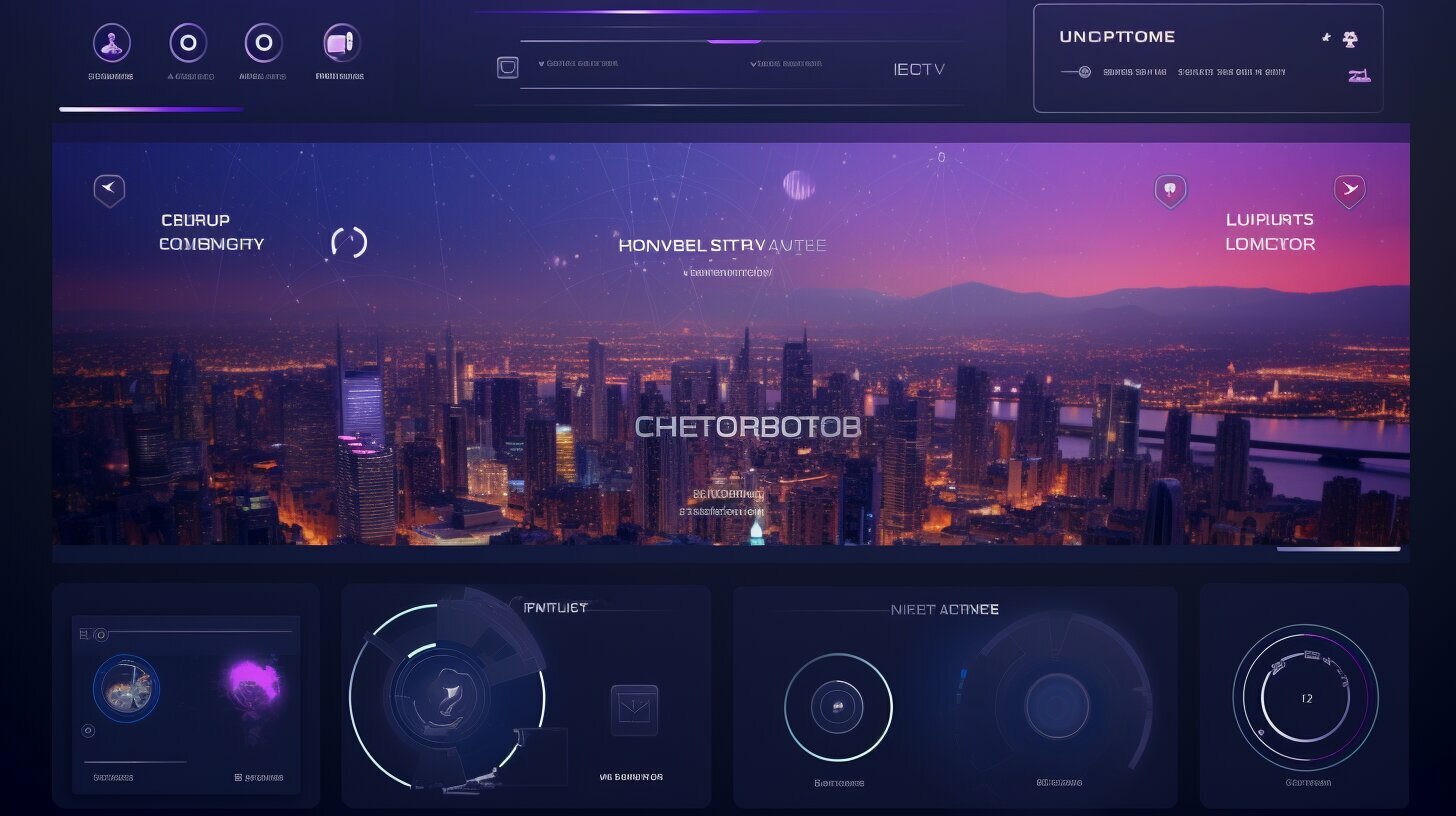Developing a video marketing strategy for agencies is crucial in today’s digital landscape. Video marketing has become increasingly popular and effective in reaching and engaging audiences. It offers numerous benefits, including increased reach, boosted engagement, enhanced SEO, higher conversion rates, better retention rates, greater trust, detailed product overviews, improved social media presence, and superior storytelling.
To create a successful video marketing strategy, agencies need to follow a systematic approach. This guide will provide an in-depth look at the key steps involved in developing a video marketing strategy tailored specifically for agencies.
Key Takeaways:
- Video marketing is vital for agencies to thrive in the digital landscape.
- Benefits of video marketing include increased reach, engagement, SEO, conversions, retention rates, trust, product overviews, social media presence, and storytelling.
- The key steps to develop a video marketing strategy for agencies include target audience selection, stakeholder connection, timeline and budget setting, distribution platform selection, messaging development, metric tracking, and incorporating different types of videos.
- Overcoming challenges like creating engaging content and maximizing budgets is crucial for video marketing success.
- A well-executed video marketing strategy can lead to increased brand awareness, customer engagement, and conversions.
The Benefits of Video Marketing for Agencies
Video marketing offers numerous benefits for agencies, including increased reach, engagement, and conversion rates. In today’s digital landscape, where attention spans are shorter than ever, videos have become a powerful tool to capture and retain audience interest. By incorporating video into their marketing strategies, agencies can effectively convey their brand messages, showcase their products or services, and connect with their target audience on a deeper level.
One of the key advantages of video marketing is its ability to increase reach. Videos are highly shareable, making them more likely to be spread across social media platforms and reach a wider audience. Additionally, videos are more likely to be clicked on and shared, boosting website traffic and enhancing brand visibility.
| Benefits of Video Marketing for Agencies |
|---|
| Increased reach |
| Boosted engagement |
| Enhanced SEO |
| Higher conversion rates |
| Better retention rates |
| Greater trust |
| Detailed product overviews |
| Improved social media presence |
| Superior storytelling |
Another significant benefit of video marketing is its ability to boost engagement. Videos are more likely to capture and retain audience attention compared to text or images. Through compelling visuals and audio, agencies can create immersive experiences that resonate with their target audience, resulting in longer viewing times and increased engagement.
“Videos are highly shareable, making them more likely to be spread across social media platforms and reach a wider audience.”
In addition to reach and engagement, video marketing also has a positive impact on SEO. Search engines prioritize video content in search results, making it easier for agencies to rank higher and increase their online visibility. By optimizing video titles, descriptions, and tags with relevant keywords, agencies can enhance their SEO efforts and attract more organic traffic to their website.
Furthermore, videos have the power to influence purchasing decisions and increase conversion rates. By showcasing products or services in action, agencies can effectively communicate their value proposition and build trust with potential customers. Additionally, videos allow agencies to provide detailed product overviews, demonstrating features, benefits, and testimonials that can help convert leads into sales. The combination of visual storytelling and persuasive messaging makes videos a powerful tool for driving conversions.
In conclusion, developing a video marketing strategy for agencies can yield significant benefits. From increased reach and engagement to enhanced SEO and higher conversion rates, videos have become a crucial component of successful marketing campaigns. By harnessing the power of video, agencies can amplify their brand messaging, engage their target audience, and achieve their marketing goals.
Choosing Your Target Audience
Identifying your target audience is a crucial step in developing an effective video marketing strategy for agencies. By understanding who your videos are intended for, you can create content that resonates with their needs and interests, leading to higher engagement and conversion rates.
One way to determine your target audience is by conducting market research. This can involve analyzing demographic data, such as age, gender, location, and income levels, to gain insights into who your potential customers are. Additionally, you can utilize psychographic information, such as interests, values, and behaviors, to further refine your audience profiles.
Once you have identified your target audience, it is important to tailor your videos to their preferences. This can include using language, visuals, and storytelling techniques that resonate with their unique characteristics. By speaking directly to your audience’s pain points and aspirations, you can establish a strong connection and build trust.
Table 1. Example Target Audience Profile
| Demographics | Psychographics |
|---|---|
| Age: 25-35 | Interests: Fitness, Healthy living |
| Gender: Female | Values: Sustainability, Personal growth |
| Location: Urban areas | Behaviors: Active on social media |
By choosing your target audience and creating videos specifically for them, you can maximize the impact of your video marketing strategy. It allows you to deliver relevant and engaging content that resonates with your viewers, leading to increased brand awareness, customer engagement, and conversions.
Connecting with Stakeholders
Building strong connections with stakeholders is essential for a successful video marketing strategy for agencies. By involving key stakeholders throughout the development process, agencies can gather valuable insights, align goals and expectations, and ensure that the video marketing strategy aligns with the overall business objectives. Stakeholders may include clients, executives, marketing teams, and creative teams.
One effective way to connect with stakeholders is by conducting regular meetings and workshops to gather their input and feedback. This collaborative approach not only ensures that all parties are on the same page but also fosters a sense of ownership and shared commitment towards the video marketing strategy. It is important to actively listen to the ideas and concerns of stakeholders and consider their perspectives when making decisions.
Another important aspect of connecting with stakeholders is effectively communicating the progress and results of the video marketing strategy. Regular reporting and updates help keep stakeholders informed and engaged, and also provide an opportunity to address any questions or concerns that may arise. By maintaining open and transparent communication channels, agencies can build trust and strengthen relationships with their stakeholders.
The Importance of Stakeholder Engagement
Strong stakeholder engagement can make or break a video marketing strategy for agencies. By involving stakeholders from the beginning and throughout the process, agencies can tap into their expertise, gain valuable insights, and ensure that the strategy meets their needs and expectations. Stakeholders can provide valuable feedback and guidance, helping agencies refine their messaging, target the right audience, and choose the most effective distribution platforms. Ultimately, stakeholder engagement leads to a more successful and impactful video marketing strategy.
| Key Benefits of Stakeholder Engagement | Key Tactics for Stakeholder Engagement |
|---|---|
|
|
By prioritizing stakeholder engagement, agencies can harness the collective expertise and support of their stakeholders, resulting in a video marketing strategy that is well-aligned, impactful, and successful.
Setting a Timeline and Budget
Setting a clear timeline and budget is crucial for the successful implementation of your video marketing strategy. A well-planned timeline ensures that you stay on track and meet your objectives within the desired timeframe. It helps you allocate resources efficiently and prioritize tasks effectively. Additionally, having a budget in place allows you to make informed decisions about the production, promotion, and distribution of your videos.
When setting your timeline, consider the different stages of video production, such as scripting, filming, editing, and post-production. Assign realistic deadlines to each stage and factor in any potential delays or revisions that may arise. It’s also important to allocate sufficient time for reviewing and approving the final videos before distribution.
As for the budget, determine how much you are willing to invest in your video marketing strategy. Consider all the costs associated with video production, including equipment, crew, editing software, and post-production services. It’s also essential to include any expenses related to promoting and distributing your videos, such as social media advertising or influencer collaborations.
| Expense Category | Estimated Cost |
|---|---|
| Video Production (equipment, crew, editing) | $X |
| Promotion and Distribution (advertising, collaborations) | $X |
| Total Budget | $X |
Remember to regularly review and monitor your budget throughout the execution of your video marketing strategy. Adjustments may be necessary based on the performance and results you achieve. By setting a clear timeline and budget, you establish the foundation for a well-structured and successful video marketing strategy.
Selecting Distribution Platforms
Selecting the right distribution platforms is key to ensuring your videos reach your target audience effectively. With the increasing popularity of video marketing, there are a variety of platforms available to showcase your content. However, it’s important to carefully consider which platforms align with your target audience and content objectives.
One popular distribution platform is YouTube, which boasts over 2 billion monthly logged-in users. It offers a wide reach and the opportunity to tap into a large audience base. YouTube’s search engine optimization (SEO) capabilities also make it a valuable platform for boosting your video’s visibility in search results. Additionally, YouTube’s advertising options, such as TrueView ads, can help you reach your target audience more effectively.
Another distribution platform to consider is Vimeo, known for its high-quality video playback and customization options. While Vimeo may have a smaller user base compared to YouTube, it attracts a more niche and creative community. This makes it an ideal platform for agencies targeting a specific audience or seeking a more premium feel for their video content.
| Platform | Benefits |
|---|---|
| YouTube | Wide reach, SEO capabilities, advertising options |
| Vimeo | High quality, niche community, customization options |
Social media platforms like Facebook, Instagram, and TikTok also offer opportunities for video distribution. Each platform caters to different demographics and content formats. For example, Facebook provides a broad reach and various ad formats, while Instagram emphasizes visuals and is popular among younger audiences. TikTok, on the other hand, is known for short-form video content and has gained significant traction among Gen Z users.
Choosing the Most Suitable Platforms
To determine the most suitable distribution platforms for your video marketing strategy, it’s essential to understand your target audience’s preferences and behaviors. Consider where your audience spends their time online and which platforms they engage with the most. This will help you focus your efforts and resources on platforms that will yield the best results.
Remember, it’s not necessary to limit yourself to just one platform. Depending on your target audience and content objectives, a multi-platform approach may be beneficial. By leveraging the strengths of different platforms, you can maximize your video’s exposure and engagement.
Ultimately, choosing the right distribution platforms plays a critical role in the success of your video marketing strategy. By carefully analyzing your target audience and their preferences, you can make informed decisions on where to showcase your videos, ensuring they reach the right people at the right time.
Developing Compelling Messaging
Creating compelling messaging is essential to capture your audience’s attention and deliver your key marketing messages effectively. In a crowded digital landscape, it is crucial to stand out and engage viewers from the moment they press play. To achieve this, you need to craft messages that resonate with your target audience and evoke a strong emotional response. Whether you’re promoting a product or service, your messaging should be clear, concise, and tailored to the needs and interests of your viewers.
To develop compelling messaging, start by understanding your target audience’s pain points, desires, and motivations. Conduct market research, analyze customer feedback, and use data to gain valuable insights. This will help you create messages that address your audience’s needs and offer solutions. While focusing on the benefits of your product or service, remember to tell a story that captivates your viewers and brings your brand to life.
Consider incorporating quotes from satisfied customers or industry experts to add credibility to your messaging. Including testimonials and endorsements can help build trust and establish your agency as a reliable and trustworthy partner. Additionally, use powerful visuals, such as images and videos, to amplify your messaging and make it more memorable.
| Key Tips for Developing Compelling Messaging: |
|---|
| 1. Clearly identify your target audience and their pain points. |
| 2. Craft messages that address your audience’s needs and offer solutions. |
| 3. Tell a captivating story that brings your brand to life. |
| 4. Incorporate quotes and testimonials to add credibility. |
| 5. Use powerful visuals to amplify your messaging. |
Tracking Key Metrics
Tracking key metrics allows agencies to assess the effectiveness of their video marketing strategy and make data-driven decisions. By analyzing the performance of their videos, agencies can gain valuable insights into audience engagement, conversion rates, and return on investment. This information helps them understand what is working well and identify areas for improvement.
One important metric to track is the number of views a video receives. This provides an indication of how many people are watching the content and can help gauge the reach of the video marketing campaign. Additionally, tracking engagement metrics such as likes, comments, and shares allows agencies to evaluate the level of audience interaction and involvement with their videos.
| Metric | Description |
|---|---|
| Views | The number of times a video has been watched. |
| Likes | The number of positive reactions to a video. |
| Comments | The number of user comments on a video. |
| Shares | The number of times a video has been shared on social media. |
Conversion tracking is another crucial aspect of measuring the success of a video marketing strategy. Agencies can track conversions by analyzing the number of leads generated, sales made, or desired actions taken by viewers after watching a video. This data provides valuable insights into the effectiveness of the video in driving desired outcomes.
In addition to these metrics, agencies can also track key performance indicators such as click-through rates, average watch time, and audience retention rates. These metrics provide insights into audience behavior and help agencies optimize their videos for better engagement and results.
Incorporating Different Types of Videos
Incorporating a variety of video types can enhance the effectiveness of your video marketing strategy for agencies. By diversifying your content and tapping into different formats, you can cater to the preferences and needs of your target audience. Here are some types of videos that you can consider:
- Explainer videos: These videos are great for introducing your agency and explaining your services or products in a concise and engaging way. Use visuals and clear narration to communicate your value proposition effectively.
- Customer testimonial videos: Showcase the positive experiences of your satisfied clients through testimonials. This type of video builds credibility, trust, and social proof.
- Educational videos: Share valuable knowledge and insights related to your industry or niche. Create tutorials, how-to guides, or informative videos that position your agency as an authoritative source of information.
- Demo videos: Demonstrate how your products or services work in action. Showcasing the features and benefits of what you offer can help potential clients understand your offerings better.
- Brand videos: Use brand videos to tell your agency’s story, values, and mission. These videos aim to create an emotional connection with your audience, leaving a lasting impression.
Remember, the key to a successful video marketing strategy is to have a mix of different video types that cater to the various stages of the buyer’s journey. Tailor your videos to align with your target audience’s needs, pain points, and preferences.
| Video Type | Purpose | Target Audience |
|---|---|---|
| Explainer videos | Introduce agency and explain services/products | New prospects, leads |
| Customer testimonial videos | Build credibility and trust | Existing clients, potential prospects |
| Educational videos | Share valuable knowledge and insights | Industry professionals, potential clients |
| Demo videos | Showcase product features and benefits | Potential clients |
| Brand videos | Create emotional connection, tell agency’s story | General audience, potential clients |
By incorporating these different types of videos into your video marketing strategy, you can maximize the impact and engagement of your content, ultimately driving better results for your agency.
Overcoming Video Marketing Challenges
Video marketing for agencies comes with its own set of challenges, but with the right strategies, you can overcome them and achieve success. Here are some key challenges that agencies face in implementing video marketing strategies, along with effective solutions:
- Creating Engaging Content: One of the biggest challenges is capturing and maintaining the attention of your target audience. To overcome this, focus on creating engaging content that resonates with your viewers. Use storytelling techniques, incorporate humor, and evoke emotion to make your videos memorable and shareable.
- Maximizing Budgets: Budget constraints can limit the production quality and reach of your videos. To make the most of your budget, prioritize high-quality content over expensive production. Optimize your video length, utilize existing resources, and explore cost-effective distribution channels to maximize the impact of your video marketing efforts.
- Staying Up-to-Date with Trends: The video marketing landscape is constantly evolving, with new trends and technologies emerging. To stay ahead, invest time in researching industry trends and studying your competitors. Experiment with innovative video formats, such as live streaming or interactive videos, to keep your content fresh and engaging.
By addressing these challenges head-on and implementing effective strategies, agencies can unlock the full potential of video marketing and achieve their goals. Remember to measure the success of your video marketing campaigns and make improvements based on the data to continually optimize your strategies.
Examples of Overcoming Challenges:
“We faced the challenge of creating engaging content for our target audience, who had a short attention span. To overcome this, we conducted extensive audience research and discovered their pain points. We then created short, informative videos that addressed their specific needs and captured their attention. As a result, our engagement rates tripled, leading to higher conversions and increased brand awareness.” – John Smith, Marketing Director
Table: Top Video Marketing Challenges and Solutions
| Challenges | Solutions |
|---|---|
| Creating Engaging Content | Use storytelling techniques, humor, and emotion in your videos |
| Maximizing Budgets | Prioritize quality over expensive production, optimize video length |
| Staying Up-to-Date with Trends | Research industry trends, experiment with innovative formats |
In conclusion, video marketing for agencies may come with challenges, but by implementing effective strategies and staying adaptable, agencies can overcome these challenges and achieve success in reaching their target audience, increasing engagement, and driving conversions.
Achieving Increased Brand Awareness
A carefully planned and executed video marketing strategy can significantly boost brand awareness for agencies. In today’s digital landscape, where consumers are inundated with information, videos offer a compelling and engaging way to capture their attention. By creating visually appealing and captivating videos, agencies can effectively convey their brand message and values to their target audience.
One effective way to increase brand awareness through video marketing is by utilizing storytelling techniques. By telling meaningful stories that resonate with the audience, agencies can create an emotional connection and leave a lasting impression. Compelling narratives combined with captivating visuals can help agencies stand out from the competition and build a strong brand identity.
In addition to storytelling, creating shareable content is key to maximizing brand exposure. When viewers find a video interesting or entertaining, they are more likely to share it with their social networks. This organic sharing can lead to increased brand visibility and attract a wider audience. Agencies can also leverage social media platforms, such as YouTube and Instagram, to reach a larger audience and generate buzz around their brand.
Table: Benefits of Video Marketing in Boosting Brand Awareness
| Benefits | Description |
|---|---|
| Increased reach | Videos can reach a wider audience and have the potential to go viral through social sharing. |
| Enhanced storytelling | Compelling narratives and visuals can create an emotional connection with the audience, leaving a lasting impression. |
| Improved brand visibility | Shareable videos can attract a larger audience and increase brand exposure. |
| Strong brand identity | Well-executed videos can help agencies differentiate themselves and establish a unique brand identity. |
In conclusion, developing a video marketing strategy that focuses on brand awareness is essential for agencies looking to stand out in a crowded market. Through storytelling, creating shareable content, and leveraging social media, agencies can effectively increase their brand visibility and build a strong brand identity. By investing in a well-planned and executed video marketing strategy, agencies can capture the attention of their target audience and ultimately drive business growth.
Enhancing Customer Engagement
Video marketing has the power to captivate and engage audiences, leading to increased customer interaction and loyalty. By leveraging the visual and auditory elements of video, agencies can create compelling content that resonates with their target audience. A well-crafted video marketing strategy can effectively communicate brand messages, evoke emotions, and create memorable experiences for viewers.
To enhance customer engagement through video marketing, agencies should focus on creating interactive elements that encourage audience participation. This can include incorporating interactive quizzes, polls, or clickable links within the video. By providing opportunities for viewers to actively engage with the content, agencies can increase the time spent watching and strengthen the connection with their audience.
Personalized messaging is another effective way to enhance customer engagement through video marketing. By tailoring content to specific segments of the target audience, agencies can deliver messages that resonate on a personal level. This can be achieved through targeted storytelling, addressing pain points, or showcasing how their products or services can solve specific problems.
Creating emotional connections is also crucial for increasing customer engagement. By appealing to the emotions of viewers, agencies can foster a sense of connection and build trust. This can be done through storytelling techniques that evoke empathy, humor, or inspiration. Additionally, integrating customer testimonials or case studies into videos can provide social proof and further strengthen the emotional bond between the agency and its audience.
| Key Strategies for Enhancing Customer Engagement through Video Marketing: |
|---|
| 1. Incorporate interactive elements such as quizzes, polls, or clickable links. |
| 2. Personalize messaging to specific segments of the target audience. |
| 3. Create emotional connections through storytelling and customer testimonials. |
“Video marketing allows agencies to connect with their audience on a deeper level, eliciting emotions and driving meaningful interactions. By incorporating interactive elements, personalized messaging, and emotional storytelling, agencies can enhance customer engagement and cultivate long-term relationships.” – Marketing expert
Driving Conversions
A well-crafted video marketing strategy can effectively guide potential customers towards conversions for agencies. By utilizing compelling visuals, persuasive messaging, and strategic calls-to-action, videos have the power to influence purchase decisions and drive action. Whether it’s encouraging viewers to make a purchase, sign up for a newsletter, or contact the agency for more information, videos can be a powerful tool for conversion optimization.
To maximize conversions, it is crucial to understand your target audience and tailor your videos to their specific needs and interests. Conducting thorough research and gathering insights about your audience’s preferences and pain points will allow you to create content that resonates with them on a deeper level. Personalization and relevance are key to driving conversions through video marketing.
In addition to understanding your audience, it is important to craft a strong call-to-action that compels viewers to take the desired action. Whether it’s displaying a clear and prominent “Buy Now” button, encouraging viewers to visit a landing page, or offering an exclusive discount, your call-to-action should be compelling, persuasive, and easy to follow. By making the next steps clear and enticing, you can guide potential customers towards the desired conversion.
| Benefits of Driving Conversions through Video Marketing |
|---|
| 1. Increased Conversion Rates: Videos have been shown to increase conversion rates by capturing viewer attention, building trust, and conveying information effectively. |
| 2. Emotional Engagement: Video content has the ability to evoke emotions and create personal connections, which can significantly impact buying decisions and drive conversions. |
| 3. Detailed Product Demonstrations: Videos allow agencies to showcase their products or services in action, providing detailed demonstrations that can effectively persuade viewers to convert. |
| 4. Testimonials and Social Proof: Incorporating customer testimonials and social proof in videos can instill trust and credibility, ultimately boosting conversions. |
| 5. Tracking and Optimization: Video marketing platforms provide valuable analytics and insights that enable agencies to track conversions, identify areas for improvement, and optimize their strategies. |
In conclusion, driving conversions through video marketing is a powerful strategy for agencies looking to increase their bottom line. By employing personalized content, compelling calls-to-action, and leveraging the emotional impact of videos, agencies can effectively guide potential customers towards conversions. Furthermore, tracking key metrics and continuously optimizing the video marketing strategy based on data will ensure ongoing success in driving conversions. With the right approach and execution, video marketing can be a game-changer for agencies seeking to achieve their conversion goals and drive business growth.
Measuring Success and Making Improvements
Regularly measuring the success of your video marketing strategy allows for data-driven improvements and long-term success. By analyzing key metrics, you can gain valuable insights into the effectiveness of your videos and make informed decisions to optimize your strategy. Here are some essential metrics to consider:
- Views: Monitoring the number of views your videos receive gives you an indication of your reach and audience interest.
- Engagement: Tracking metrics like likes, comments, and shares helps you gauge how well your videos are resonating with your audience.
- Conversions: Assessing the number of conversions, such as clicks to your website or form submissions, provides insights into the impact of your videos on driving actions.
- Retention: Understanding how long viewers watch your videos can help you identify areas for improvement in terms of content engagement and viewer attention.
- ROI: Calculating the return on investment from your video marketing efforts helps determine the effectiveness of your strategy and allocate resources more efficiently.
By tracking these metrics and analyzing the data, you can identify patterns, trends, and areas of improvement. For example, if a particular video has low engagement, you can modify your messaging or content strategy to better capture your audience’s attention. Similarly, if a video has a high conversion rate, you can replicate its success in future campaigns.
It’s important to have a systematic approach to measure success and make improvements. Regularly review and analyze your video metrics, set clear goals for each video campaign, and adjust your strategy based on the insights gained. This iterative approach allows you to continuously optimize your video marketing efforts and achieve long-term success.
| Metric | Description |
|---|---|
| Views | The number of times your videos have been watched |
| Engagement | The level of interaction and audience response to your videos, including likes, comments, and shares |
| Conversions | The number of desired actions taken as a result of watching your videos, such as clicks to your website or form submissions |
| Retention | The average duration viewers watch your videos, indicating their level of interest and engagement |
| ROI | The return on investment from your video marketing efforts, measuring the financial impact of your strategy |
Staying Ahead in the Video Marketing Landscape
To maintain a competitive edge, agencies must stay up-to-date with the latest developments in the video marketing landscape. The digital world is constantly evolving, and new trends, technologies, and platforms emerge regularly. Adapting to these changes is crucial to ensure success in video marketing strategies.
One way to stay ahead is by keeping a close eye on emerging platforms and trends. For example, the rise of live streaming and short-form videos on platforms like TikTok presents new opportunities for agencies to engage with their target audience. By exploring and experimenting with these platforms, agencies can find innovative ways to incorporate them into their video marketing strategies.
Table 1: Emerging Platforms in the Video Marketing Landscape
| Platform | Key Features |
|---|---|
| TikTok | Short-form videos, music integration, viral challenges |
| Instagram Reels | Short-form videos, editing features, music selection |
| LinkedIn Native Video | B2B-focused video content, professional networking |
Additionally, agencies must stay informed about the latest advancements in video production and editing techniques. Technologies like 360-degree video, virtual reality, and augmented reality are transforming the way videos are created and consumed. By embracing these innovative approaches, agencies can deliver immersive and interactive experiences to their audience, setting themselves apart from competitors.
It is also essential to monitor industry trends and consumer behavior. Understanding the preferences and expectations of the target audience allows agencies to create relevant and compelling video content that resonates with viewers. By analyzing data, tracking key metrics, and conducting audience research, agencies can gain insights into what works and make informed decisions for their video marketing strategies.
Staying ahead in the video marketing landscape requires continuous learning, adaptability, and a willingness to explore new possibilities. By embracing emerging platforms, leveraging innovative technologies, and staying in tune with industry trends, agencies can maximize the impact of their video marketing strategies and maintain a competitive edge in the ever-evolving digital landscape.
Conclusion
Developing a well-thought-out video marketing strategy is crucial for agencies to effectively reach and engage their target audience. In today’s digital landscape, video marketing has become increasingly popular and effective in capturing the attention of viewers. By incorporating video content into their marketing efforts, agencies can reap various benefits.
Video marketing offers increased reach, allowing agencies to connect with a broader audience and expand their brand’s visibility. It also boosts engagement through captivating visuals and storytelling, encouraging viewers to spend more time interacting with the content. Furthermore, video marketing enhances SEO by improving website rankings and attracting organic traffic.
A well-executed video marketing strategy can lead to higher conversion rates, as videos have the power to effectively convey product information and persuade viewers to take desired actions. Moreover, videos contribute to better retention rates, as they leave a lasting impact on viewers, increasing brand recall and loyalty.
Developing a video marketing strategy involves various key considerations, such as choosing the target audience, connecting with stakeholders, setting a timeline and budget, selecting distribution platforms, developing compelling messaging, and tracking key metrics. By incorporating different types of videos, such as explainer videos, customer testimonials, educational videos, demos, and brand videos, agencies can engage their audience in diverse ways.
Although video marketing comes with its challenges, such as creating engaging content and maximizing budgets, agencies can overcome them by staying up-to-date with industry trends and consistently optimizing their strategies. By measuring the success of their video marketing efforts and making improvements based on data, agencies can continuously refine their strategies and stay ahead in the ever-evolving video marketing landscape.
In conclusion, a well-planned and executed video marketing strategy can lead to increased brand awareness, customer engagement, and conversions for agencies. By harnessing the power of video, agencies can effectively communicate their message, captivate their audience, and achieve their marketing goals.
FAQ
Q: What are the benefits of video marketing for agencies?
A: Video marketing offers increased reach, boosted engagement, enhanced SEO, higher conversion rates, better retention rates, greater trust, detailed product overviews, improved social media presence, and superior storytelling.
Q: How should I choose my target audience for video marketing?
A: It is important to identify your ideal audience and tailor your videos to their needs and interests. Conduct market research and analyze demographics, behaviors, and preferences to determine your target audience.
Q: Why is connecting with stakeholders important in developing a video marketing strategy?
A: Involving key stakeholders helps gather insights, align goals and expectations, and create a strategy that meets their needs. Stakeholders can provide valuable input and ensure a successful implementation of the video marketing strategy.
Q: How do I set a timeline and budget for my video marketing strategy?
A: Determine realistic timelines for video production, distribution, and marketing activities. Allocate resources effectively by considering production costs, advertising budgets, and any external services required.
Q: How do I select the best distribution platforms for my video marketing strategy?
A: Consider your target audience and content objectives when choosing distribution platforms. Evaluate platforms such as YouTube, Facebook, Instagram, LinkedIn, and your own website to determine which ones align with your goals.
Q: How can I develop compelling messaging for my video marketing strategy?
A: Craft persuasive and impactful messages by identifying your unique selling points, understanding your audience’s pain points and desires, and creating a story that resonates with them. Use clear and concise language to effectively communicate your message.
Q: What metrics should I track to measure the success of my video marketing strategy?
A: Track metrics such as views, engagement, conversions, click-through rates, and return on investment (ROI). Analyzing these metrics will help you gauge the effectiveness of your strategy and make data-driven improvements.
Q: What types of videos can I incorporate into my video marketing strategy?
A: Consider using explainer videos, customer testimonial videos, educational videos, demo videos, and brand videos to engage your audience and convey your message effectively.
Q: What are common challenges in video marketing for agencies?
A: Creating engaging content and maximizing budgets are common challenges. Overcome them by focusing on quality storytelling, understanding your audience, conducting thorough research, and making strategic investments.
Q: How does a video marketing strategy contribute to increased brand awareness?
A: A well-executed video marketing strategy can enhance brand awareness through storytelling, captivating visuals, and shareable content. Videos have the potential to reach a wider audience and leave a lasting impression.
Q: How can video marketing enhance customer engagement?
A: Video marketing can enhance customer engagement by incorporating interactive elements, personalized messaging, and creating emotional connections with your audience. It allows you to communicate your brand’s value and build stronger relationships.
Q: Can a video marketing strategy drive conversions?
A: Yes, a video marketing strategy can drive conversions by utilizing persuasive calls-to-action, showcasing product benefits, and incorporating testimonials that provide social proof. Engaging videos can motivate viewers to take desired actions.
Q: How can I measure the success of my video marketing strategy and make improvements?
A: Measure success by tracking key metrics such as views, engagement, conversions, and ROI. Analyze the data to identify areas for improvement and make data-driven decisions to optimize your video marketing strategy.
Q: How can agencies stay ahead in the rapidly evolving video marketing landscape?
A: Adapt to technological advancements, changing consumer preferences, and emerging trends. Stay updated with industry news and continuously experiment with new video formats, platforms, and strategies to stay competitive.







